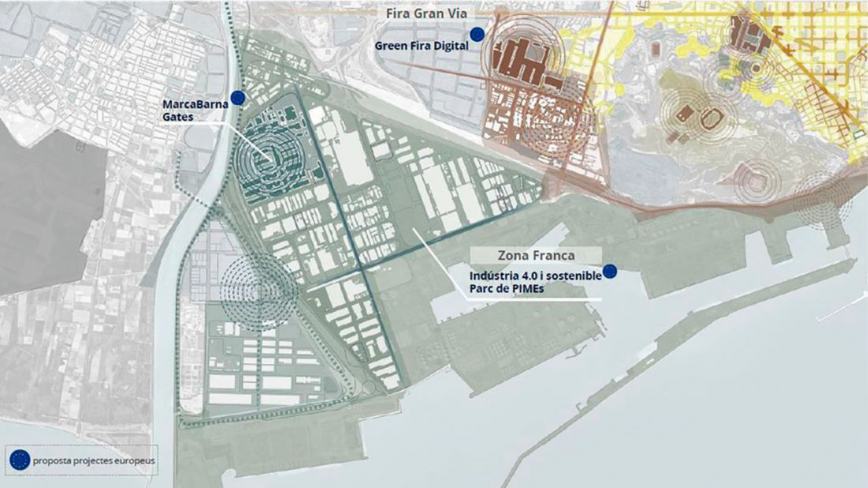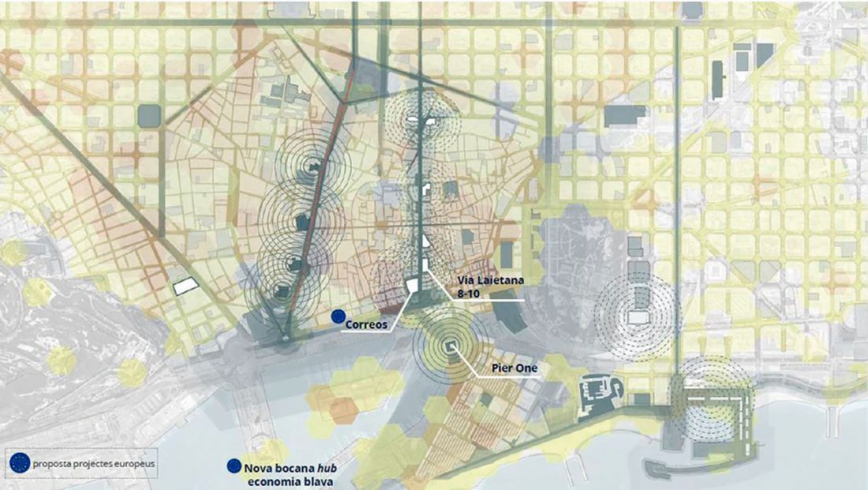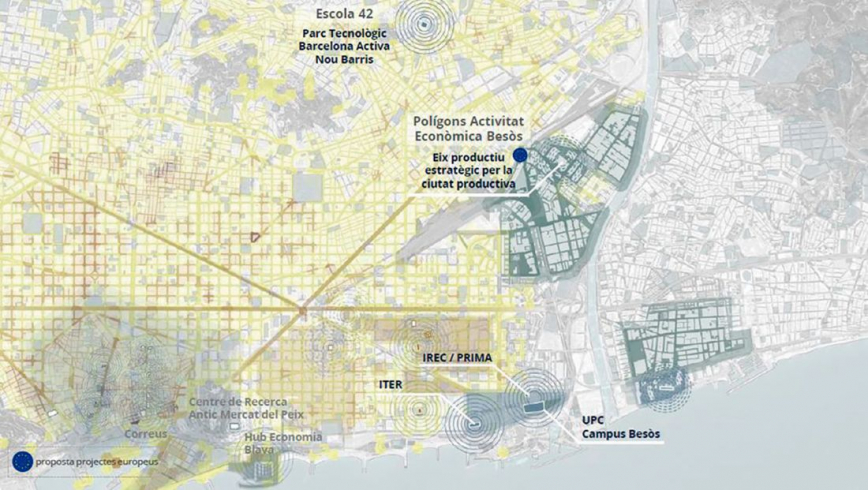Barcelona is a global city immersed in urban transformation processes linked to economic competitiveness, social equality, environmental sustainability and public health, factors already palpable in Ildefons Cerdà’s urban planning in the 19th century and that is redefined by each generation according to the circumstances of their time. It is up to our generation to take on these challenges in the wake of the COVID-19 crisis, bearing in mind the digital and ecological transitions that shall define this decade.
Cities behave like living organisms, evolving and transforming to adapt to the environment. Each city has its own DNA, an accumulated set of codes granted, acquired or invented over the centuries and which become the guiding structures, ideas and strengths that underpin any city’s unique mindset. In Barcelona, this DNA incorporates the local feel of the city and its love for outdoor space, the readiness to pioneer changes and spearhead reforms, the global perspective and the instinct for connection and prominence around the world, and the determination to dream big and shape the future through collective “reinvention” projects. Barcelona is a muse for the lives of all those living in the city, and calls them to be inspired by its history and its amassed initiatives.
Barcelona is the heir to a huge urban planning legacy, a treasure we are still learning from today. From Cerdà’s Eixample [extension] to the Olympic transformation, the trinomial urbanism-economy-social equality is an integral part of the city and this is how we will keep rethinking it. It was Pasqual Maragall, the mayor who spearheaded the transformation of the most admired city in the world, who pointed out the erroneous trend of classical and neoclassical economics, focused on disregarding space and forgetting that its forms inspire and enhance economic processes. In the city, and in the urban economy, space design and organisation are key factors. As cities move toward a new urban economy, different from a digital — but complementary — economy, it will be the nature of the place and the space that will give cities an advantage.
The Barcelona Green Deal evolved into one clear priority goal: to revive Barcelona in the wake of the effects of the pandemic we are still in the throes of.
Economy and urban space
The relationship between the economy and urban space addresses the social imperative underpinning the vitality and momentum of all cities. Cities’ economic strategies depend on the growth of jobs in physical places that contribute to the formation of specialised clusters, or places that can balance different economic sectors by combining the facilities and amenities necessary for a rewarding mix of uses. The ability to combine different activities in the same spaces and places at different times of the day and week is a unique feature of cities, which is conducive to the strengthening of several ecosystems in places where they can benefit from proximity. This means that the revived post-pandemic city can adapt to the needs of the surroundings, promoting a new generation of more socially and economically sustainable neighbourhoods.
In January 2020, the Department of Economy, Employment, Competitiveness and Tax at Barcelona City Council presented the Barcelona Green Deal, the city’s new economic agenda for the year 2030, at the Cercle d’Economia economic forum. This new agenda identifies priority sectors for achieving a new, more competitive, more sustainable and more equitable city model. Following the impact of the double health and economic crisis brought about by COVID-19, in April 2021, working meetings were held at the Barcelona Disseny Hub with regard to reactivating the city's economy, Barcelona ReAct. It marked an opportunity to continue working on the Barcelona Green Deal, discussing local solutions to global problems and engaging in constructive dialogues with all the city’s economic and social agents.
The Barcelona Green Deal evolved into one clear priority goal: to revive Barcelona in the wake of the effects of the pandemic we are still in the throes of. This new economic agenda proposes reactivating the city through projects that allow us not only to return to where we were before, but also to move towards a more ambitious future for all of Barcelona’s citizens. And that future must be defined with its sight set on a three-fold dimension: the global, the metropolitan and the local.
 Projects in the area of Zona Franca and La Marina del Prat Vermell. © Barcelona City Council
Projects in the area of Zona Franca and La Marina del Prat Vermell. © Barcelona City CouncilLocal solutions to global problems
In any ordinary year, a conference held in Barcelona on the future economy of cities would be a long-awaited event. But in 2021, this event not only comes as a surprise, but more of a shock and an epiphany. When we met in Barcelona from 13 to 16 April, for many people it was the first face-to-face event they had attended in twelve months. This meeting was another example of how Barcelona is a city that sets new trends, a city that shows how agendas can be powered up with an inspiring environment.
The pandemic has left city planners around the world with a dilemma. On the one hand, the lockdown left us hungry and thirsty to share spaces in the city that were the setting and support for our lives. On the other hand, the huge increase in digital and virtual life seemed to herald the beginning of a new cycle of hybrid cities and combined lifestyles, a quantum leap in our understanding of the complex relationships between space, economy, technology, people, planet, identity and sense of belonging.
Cities need to be good at things that cannot be done online if they wish to succeed and thrive.
The pandemic is triggering a series of changes in medium-term behaviours that will impact our cities through the constantly changing demand patterns of the new economic cycle, a cycle that will manifest itself as the virus gradually disappears from our lives. These changes have multiple dimensions rooted in the speeding up of digitisation and the decarbonisation of the economy, labour relations, consumer habits, and urban systems. These medium-term changes may include: a rise in teleworking; an increase in takeaway and online shopping; a drop in the number of international tourists, students and congress-goers; an increase in digital leisure; a fall in public transport users; and a rise in the digitisation of services such as banking, health care and local government services, which could further reduce the physical presence of activity in city centres.
Everything that can be done easily and efficiently online will start to be done online. The pandemic has a “classification effect”. In the post-pandemic world, there is a new equation between virtual and physical presence. The pandemic has acted as unwanted proof of the concept of digital life and work, and the city must find and focus on things that can only be done face to face and in a physical space. A new emphasis is placed on experience, innovation, creativity, culture, health, habitat, live events and place creation. Cities need to be good at things that cannot be done online if they wish to succeed and thrive. This is a major and enriching change for cities.
These transformations are not devoid of risks for cities that are only slowly adjusting. The combined effects of several of these medium-term changes of behaviour in our city centres could be such that the “separation” of the mix of uses in the city occurs in some places and then speeds up in a clear cycle of decay.
 Points of the ReAct programme in Montjuïc. © Barcelona City Council
Points of the ReAct programme in Montjuïc. © Barcelona City CouncilTowards a new future
But this pandemic can also be seen as an opportunity for our city centres to move towards a new future. We can reform our cities based on the things they are good at. It is important to reinvent and revive our cities around roles that do not compete with online platforms and domains, but that can complement and benefit from them, equipping our cities and urban economies to flush out carbon dioxide and improve liveability and air quality.
Against this backdrop, cities have opportunities to increase housing for local residents, to speed up the reduction of carbon emissions, to prioritise health and city centres with cleaner air, to focus on the economy of innovation, to develop their role as hubs of knowledge, to broaden unique experiences for visitors and to explore a new agility and a more imaginative use of open spaces and buildings with functions that are no longer needed. These opportunities provide cities with the opportunity to reposition themselves in the post-pandemic context, better combining the available amenities into a new attractive mix for different groups of people.
 City centre transformation plan. © Barcelona City Council
City centre transformation plan. © Barcelona City CouncilConnectivity is an essential platform for these opportunities. Technology and digital domains, in addition to enabling online shopping and flexitime, provide tools and data to make city centres more successful. Digital platforms can enhance the agility and utilisation of buildings and space, optimising their performance and reducing waste. Technology can also improve safety and can contribute to the quality and health of public spaces. Social media platforms also provide means to generate affinity and drive demand for the city’s amenities. Artificial intelligence systems and IoT (Internet of Things) platforms can boost the efficiency of densely used spaces and better target opportunities and resources. There is a trade-off between the physical and the digital, they are complementary, but their dominance in different activities is changing.
Barcelona is already the world capital of mobile technologies. Therefore, showing the world how to solve the urban issues associated with digital life is a natural role for the city. The Barcelona ReAct conference chose these topics as a backdrop and built a rich vision of green, blue, health, food, science, public space, water, air, ideas, art, business and talent. And, behind all this, the idea of the city as a platform for place, belonging and collaboration. The conference laid out a new programme: Barcelona is, once again, a leader in trends and agendas for debate.
 22@ district projects. © Barcelona City Council
22@ district projects. © Barcelona City CouncilInfrastructures, areas of economic transformation and tractor projects
To implement the agenda emerging from Barcelona ReAct, the Barcelona Green Deal promotes an equitable, sustainable and competitive economy, with high-calibre opportunities and employment in strategic sectors such as biotechnology and health sciences, ICT, creative industries and the 4.0 industry. And it also promotes a Barcelona with a sustainable tourism economy and one that is distributed throughout the city, which exists alongside more liveable neighbourhoods, more green spaces and refurbished eco-friendly buildings, in which precedence is given to local commercial activity.
Like all world cities, Barcelona’s competitiveness will be determined by its degree of metropolitan, international and digital connectivity. Barcelona must be at the forefront of investment in connectivity infrastructures (port, airport, train, metro, 5G, etc.) to lead a digital humanism while strengthening its position as a digital capital and catalyst for local and global innovation and entrepreneurship ecosystems.
In addition to the cross-cutting proposals of economic development policies throughout the city, the Barcelona Green Deal identifies five areas of economic transformation as spaces of opportunity: the Zona Franca, Montjuïc, the city centre, the 22@ innovation district and the Besòs industrial area. In each of these areas, the City Council fosters tractor projects that revitalise neighbourhoods and generate synergies with the assets and economic and social ecosystems that already exist in the city.
 The future of Besòs with the ReAct programme. © Barcelona City Council
The future of Besòs with the ReAct programme. © Barcelona City CouncilOver the next decade, Barcelona will rekindle its DNA, strengthening issues such as attracting talent, local production, reindustrialisation and the city’s international calling.
This new “roadmap” will develop a new “mind map” for the city. As in the past, a new transformative power has been seized to reinvent the city; this energy is returning to Barcelona. Over the next decade, Barcelona will rekindle its DNA, strengthening issues such as attracting talent, local production, reindustrialisation and the city’s international calling. The Barcelona Green Deal promotes a more equitable, more competitive, more sustainable and healthier city, a Barcelona of opportunities that form the backbone of the metropolitan region and opens up to the world as an adjusted global city and one aligned with planetary imperatives.
The Zona Franca will maintain more logistics and neo-industry services (sustainable and digitised industry) and, together with the new Marina del Prat Vermell neighbourhood, will form a new centrality and will redraw urban dynamics in a strategic location between Barcelona’s port and airport.
Montjuïc promotes activities in the sports and culture economy, such as the new Sports Tech Hub. The Fira de Montjuïc convention centre will continue to promote Barcelona as a city of exhibitions and will evolve as a dynamic economic hub that revitalises the surrounding neighbourhoods.
In the centre of Barcelona (the Ciutat Vella district and its surrounding neighbourhoods), the proposal is to promote a balanced economy, which improves the synergies between knowledge-intensive activities and the use of the neighbourhood’s proximity, to enjoy a centre where you can live, work and visit. Some of the chief projects in this transformation include the Correus post office building (an emblematic building currently underused), which will become a hub of economic impetus while generating jobs and high value-added services for the neighbourhood; and the Port Olímpic, recovered as a space open to the public, which will host a Blue Economy Hub, which will generate synergies with sports, nautical activities and gastronomy.
The 22@ district is advancing as a driver of the city’s innovation and creativity, with a mix of uses and quality of life, in which the City Council will consolidate two new axes: the “creative mile” on the street Carrer Pere IV and the green axis on the street Carrer Cristóbal de Moura.
The industrial estates of the Besòs Axis are the city’s other major lung of production, which in the coming years will be affected by the transformation of the surroundings of La Sagrera train station. It is an industrial area, fully integrated into the urban fabric, which will promote the location of neo-industrial activities, last-mile sustainable urban mobility activities and initiatives related to the green and circular economy.
The newsletter
Subscribe to our newsletter to keep up to date with Barcelona Metròpolis' new developments





